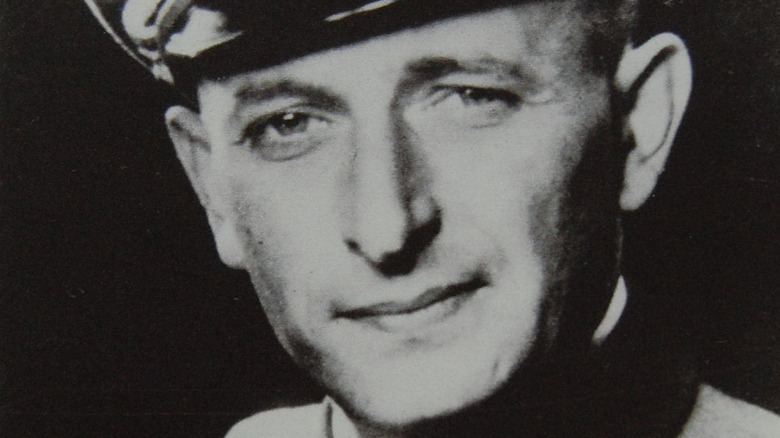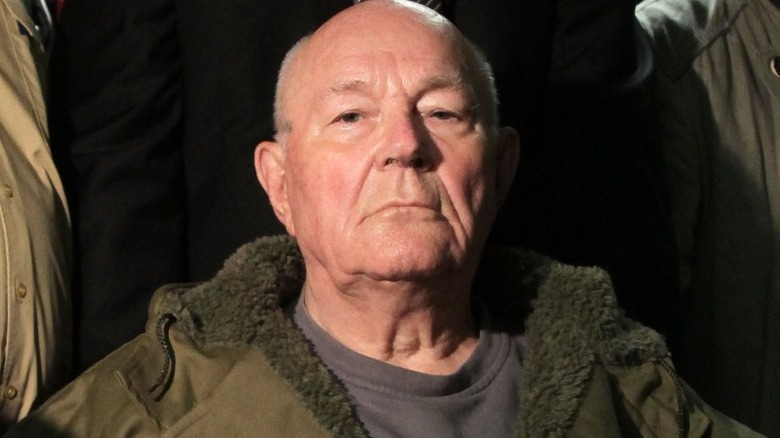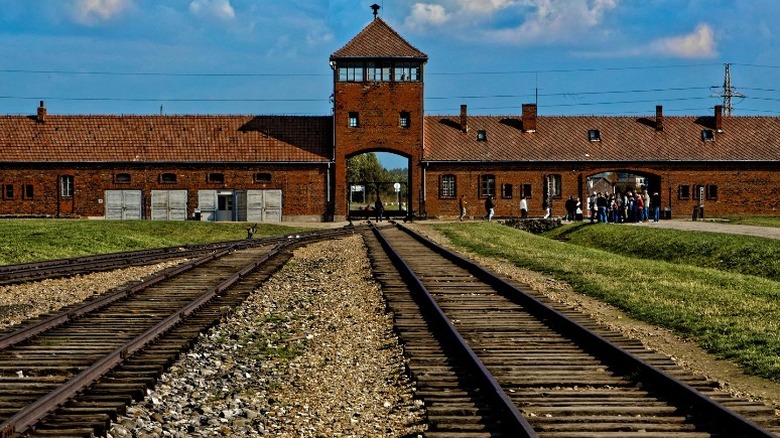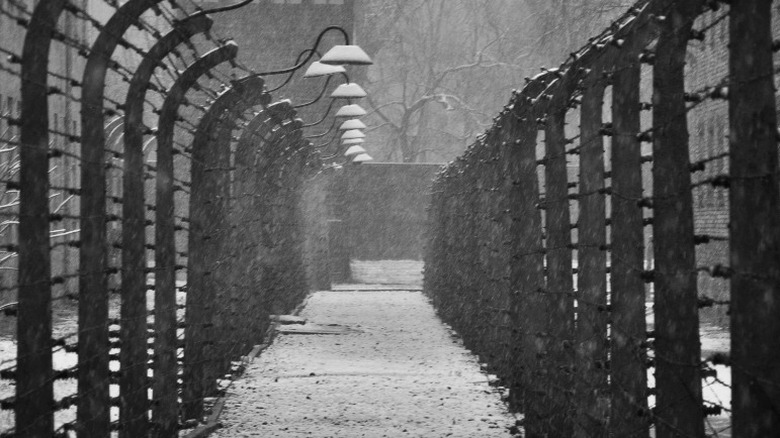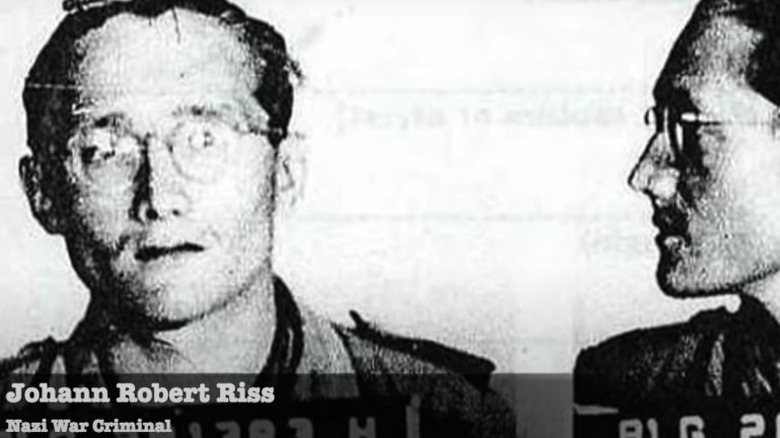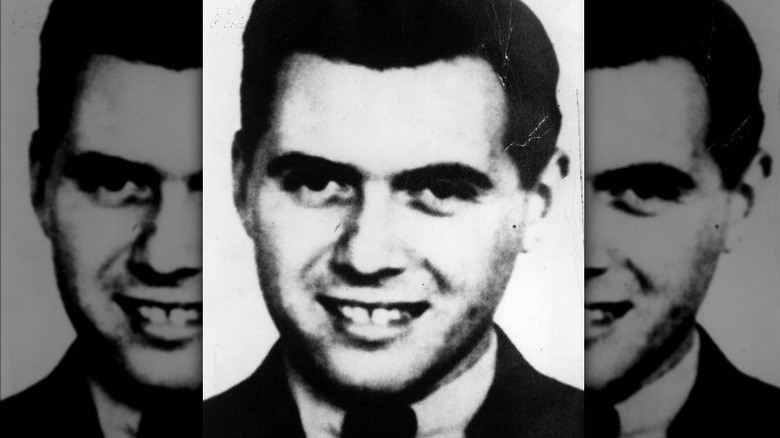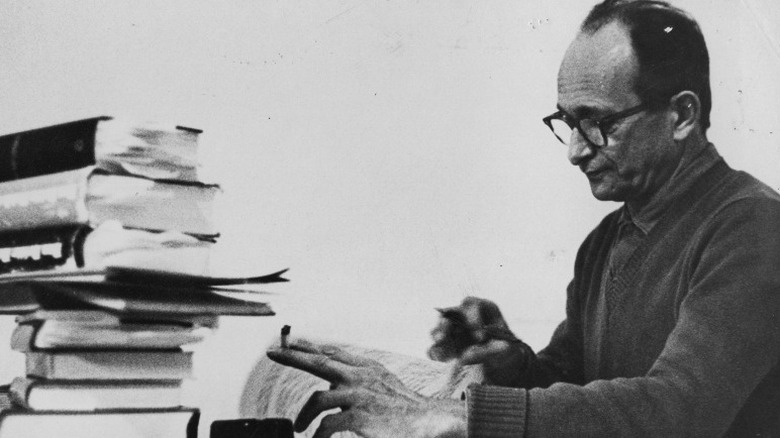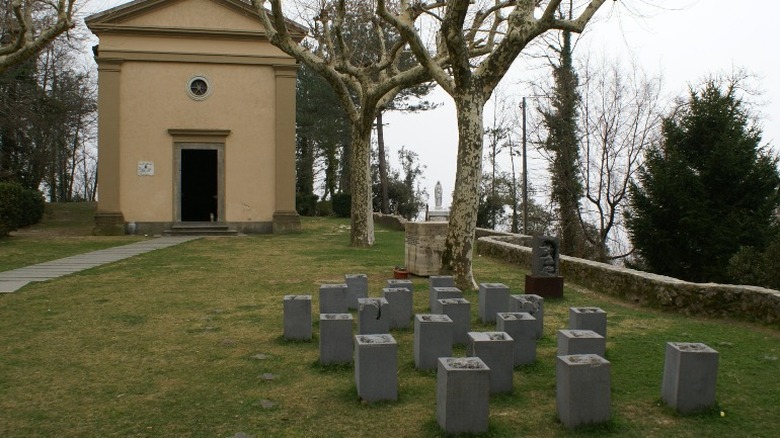The Most Wanted Nazis Of All Time
Allied forces tried and convicted a number of Nazi war criminals after the end of World War II. The most famous court proceedings, known as the Nuremberg Trials, only put 22 of the Nazi leaders on trial, however (per The United States Holocaust Memorial Museum). Of the 22 brought to court, 19 were convicted, and 12 were sentenced to death. Among those condemned to the noose were Reich Marshall Hermann Göring and Hans Frank. Other Allied-led tribunals followed until April of 1949, leading to an additional 97 convictions.
Germany held its own set of trials for mostly lower-level officers, rank and file military, and others associated with the horrific war crimes perpetrated by the Nazi regime. Over time, more than 900 court proceedings were conducted but were subject to global scrutiny as many defendants were either acquitted or received very light punishments. Elsewhere in Europe, other nations that were Nazi-occupied held their trials, incarcerating and executing former Nazis as well as those who assisted them. CNN reports that out of the nearly 150,000 suspected war criminals that were brought to trial, convictions were handed out to a mere 6,656.
Many high-ranking members of the Nazi party and the German military fled Germany, evading prosecution. Several were revealed to have escaped to Argentina, with Yahoo News UK reporting that this South American nation housed an estimated 12,000 of them under aliases. Over the years, justice has been served to some of them before they were taken by time.
John Demjanjuk
John Demjanjuk had quite the story. The Ukrainian soldier claimed for years that he was a prisoner of war and nearly starved to death while at a Nazi-controlled camp. After the war, he worked in Germany as a driver before moving to the United States in the early 1950s. Years later, he was accused of being the notorious "Ivan the Terrible" at the Treblinka concentration camp (per BBC News). He was deported from the U.S. in 1986 and put on trial in Israel. Convicted and sentenced to death, Demjanjuk was able to successfully appeal his conviction after it was revealed that this was a case of mistaken identity. The Israeli Supreme Court overturned it in 1993 and he returned to the U.S.
Though innocent of crimes at the Treblinka camp, German officials announced in 2008 that they had enough evidence to try him as an accessory to 27,900 murders at Sobibor, another camp where he was believed to have been a guard. German officials claimed that, though taken prisoner while fighting for the Red Army, he was recruited by the Nazis to be an SS guard at the camp. His job at the camp was enough for him to be charged and brought to trial (via BBC News).
Demjanjuk unsuccessfully fought his extradition to Munich, where he was put on trial and convicted. Sentenced to five years, he was released to a nursing home pending the appeal of his conviction. This is where he died in 2011.
Laszlo Csatary
Not all Nazi war criminals fled to the safe haven of Argentina after the war. Laszlo Csatary, the head of a Hungarian policing unit during World War II, evaded authorities by changing his name to Lazlo Csizsik and moving to Canada in 1949. He lied to officials there and claimed to be from Yugoslavia (per CNN).
Csatary was wanted for sending more than 15,000 Jews to the Auschwitz concentration camp in 1944. Using his authority as a senior officer, he was able to round up Jews from ghettos in the city of Kosice. CNN tells us that he was also responsible for sending 300 to their deaths in Ukraine.
After suspicions were aroused during an investigation into his life during the 1990s, Canadian officials revoked his citizenship in 1997. Csatary left Canada on his own accord shortly thereafter, settling in Hungary. In 2011, tips led government officials there to investigate his actions during World War II. He was arrested in June 2012 but died August 2013 at the age of 98, before he could go to trial. The Simon Wiesenthal Center, the Jewish rights organization that found him living in Hungary, declared that before his death that he was the most-wanted known Nazi war criminal.
Hans Lipschis
Hans Lipschis was able to avoid arrest until the age of 93. Though it was widely known that Lipschis was employed at the Auschwitz concentration camp, he had always maintained that he was only there as a cook. His duties there kept him from ever seeing the gas chambers, and he stated he had nothing to do with the extermination of the prisoners held there (per BBC News).
Lipschis left Germany for the United States in the mid-1950s, settling in Chicago. But the U.S. government threw him out of the country in the 1980s on the charge that he intentionally hid his connections to the Nazi government. Lipschis returned to Germany in 1983.
The Times of Israel reports that prosecutors were able to build their case against Lipschis, whom they maintained was a guard at the death camp. They charged him with 10,510 counts of accessory to murder in 2013. His defense approached the court and showed evidence that their client was suffering from dementia and made a case strong enough that Lipschis was deemed unfit to stand trial. The accused Nazi war criminal died in 2016.
Johann Robert Riss
In 2011, Johann Robert Riss was found guilty by an Italian court for his participation in the grisly massacre of nearly 200 civilians in the small Tuscan village of Padule di Fucecchio (per The Daily Mail). The source reports that Riss was one of three former SS officers who commanded the deaths. Most of those murdered were mowed down by machine gun fire. A year after the 1944 slaughter, a British officer took numerous statements from witnesses, who identified Riss as one of the ringleaders.
According to History, the murders were an act of retaliation. Resistance fighters in the village had shot and killed two Nazi soldiers. Though it took years to put a case together, prosecutors were successful in getting their guilty verdict returned. But, as Time Magazine reports, it was more of a symbolic gesture. The German government refused to extradite Riss for trial and has not allowed Italian officials to have access to Riss after his conviction. As far as it can be known, Riss is still living in Germany under the radar. He's one convicted Nazi war criminal who, though found guilty in a court of law, might never be served justice.
Algimantas Dailide
Algimantas Dailide was a Lithuanian teen expelled from school for speaking out against Soviet rule under Stalin in 1940 after the Soviets annexed his country. The 19-year-old Dailide witnessed the Nazis invading his country and occupying it in 1941. The Nazi government reestablished the Saugumas, a police agency that had been disbanded by the Soviets. Dailide secured a position as a desk clerk with this agency before being taken into a patrol division (per Justia US Law).
Facing History tells us that 160,000 Jews were living in Lithuania at the time of the Nazi occupation. With yet another promotion in the Saugumas, Dailide became an information officer, tracking the whereabouts of both Jews and Communists. Jews were herded into two ghettos, the last stop for many who would later be sent to their deaths in concentration camps. Dailide was instrumental in turning 12 Jews over to higher authorities when they escaped the ghettos. These individuals were then sent to be executed by Nazi soldiers (via History).
After the war, Dailide fled to Germany and later to the United States. He enjoyed a career as a real estate agent in Florida until it was discovered that he had lied about his connection to the Nazi regime while in Lithuania. Expelled from the U.S., he returned to Germany in the late 1990s. Tried in absentia in Lithuania for his crimes, he was later deemed too frail for prison, making him yet another convicted war criminal allowed to remain free.
Alfred Stark
As the tide began to shift during World War II in favor of the Allied forces in Eastern Europe, the breakup of Mussolini's Italy and Hitler's Germany was imminent. With Italy breaking its alliance with the Nazis in 1943, many Italian-occupied locations were being eyed by the Germans, who began to send in reinforcements (via Deutsche Welle). Some members of the Italian military sided with the Nazis, while others fought against them. One such place that had a brief Italian military resistance was the Greek island of Kefalonia. After more than 1,000 Italian troops were killed in battle, this regiment surrendered.
But the surrender wasn't good enough for the Nazi command. They executed more than 5,000 Italian troops who had laid down their arms. This incident was the basis for the 1994 novel "Captain Corelli's Mandolin" by Louis de Bernières.
One German officer who led the campaign to murder the new prisoners of war was Alfred Stark, a Nazi Corporal (per The Guardian). Stark was accused of being an active participant in the execution of at least 117 Italian officers who had surrendered. Convicted years later in absentia in Greece, Stark was never handed over to authorities.
Vladimir Katriuk
Vladimir Katriuk is yet another example of how the horrors carried out by the Nazis during World War II weren't just limited to the concentration camps. Katruik was accused of being responsible for war crimes in the city of Khatyn, in modern-day Belarus. CBS News reports that Katruik had served as a member of the SS from 1942 until 1944 in a battalion of troops from Ukraine.
During the incident in question, eyewitnesses reported that Katruik waited outside a barn that was filled with civilians who were attempting to hide from SS troops. After the barn was set on fire, Katruik was said to have opened fire on the fleeing masses with a stationary machine gun.
After the war, Katriuk fled to France before establishing residency in Canada in 1951. A federal court in Canada found that he lied about his connection to the Nazis to get his Canadian citizenship. But they further ruled that they could not establish a firm connection between Katriuk and any war crimes. Though widely believed to have been responsible for the massacre in Khatyn, he was never put on trial. He died while still residing in Canada in 2015.
Josef Mengele
Josef Mengele is affiliated with two gruesome roles at the Auschwitz concentration camp. Known as the "Angel of Death," one of Mengele's roles as a camp physician was to routinely tour the prison barracks and hand-select those who were fit for physical labor and those who would be sent to their deaths in the gas chambers. The United States Holocaust Memorial Museum reports that Mengele would often be seen skulking near the train platforms whenever new trains full of Jewish prisoners would arrive, searching for victims for the second thing he is notoriously known for.
Mengele was obsessed with twins and would constantly search the camp for them so that he could subject them to cruel experimentation. His torture wasn't saved just for twins, however. Mengele tortured and murdered countless victims in his insane quest to discover Roma and Jewish resistance to certain diseases.
After the war, Mengele was briefly in U.S. custody but was released as they didn't realize that he was on the war crimes list. He fled to Argentina, where he stayed until 1960. Frightened for his safety after the capture of Eichmann, Mengele traveled to Paraguay before settling in Brazil. He lived there until he had a stroke while swimming and drowned in 1979. Buried under the name Wolfgang Gerhard, he was later exhumed. DNA confirmed that the body was that of Mengele.
Adolf Eichmann
The architect of Hitler's "Final Solution to the Jewish Problem" was SS officer Adolf Eichmann. He had been captured by Allied forces but in 1946 was able to escape from the camp that he was held in before standing trial (via History). Like many higher-ranking Nazi officials, Eichmann fled to Argentina under an assumed name.
Word got back to the Israeli government that Eichmann was living in the South American nation under the alias Ricardo Klement. Wanting justice for the man who organized the system that led to the deaths of millions of Jews, the Israelis dispatched a team of Mossad agents to Argentina. With full awareness that Argentina would not extradite any Nazi war criminal, Mossad launched a plan to nab him and fly him to Israel to stand trial. After locating Eichmann and verifying his identity, Mossad agents abducted the former SS officer as he was walking home. Eichmann was dressed in an Israeli airline worker's uniform and heavily drugged. He was carried onto a plane under the ruse that he was an airline worker who was injured in an accident.
The trick worked, and Eichmann was soon in Israel. The Argentinian government was pretty angry and being tricked and demanded Eichmann's return. Israel stood their ground, claiming that since he was a wanted international war criminal that they had every right to capture him. Convicted of crimes against humanity in a televised trial, Eichmann was sentenced to death and sent to the gallows, where he was hanged.
Oskar Groenig
On March 12, 2018, the BBC reported the death of another convicted Nazi war criminal who passed away peacefully as a free man. Oskar Groening had been tried and convicted of war crimes in 2015 and sentenced to serve four years in prison for his various offenses. But due to his multiple appeals, Groenig was never to serve his sentence before dying.
Dubbed "The Bookkeeper of Auschwitz," Groenig's job was to itemize and catalog all of the valuables that were seized from incoming Jews to the camp. What makes Groenig unique is his admission to the horrors of the concentration camp. Staying in Germany and working in a glass factory after the end of World War II, Groenig decided to break his silence after he grew alarmed that so many people were denying the existence of the holocaust. He spoke to interviewers in a BBC documentary in 2005 where he described in detail the death camp that employed him. Though he never made any admission to being directly responsible for any deaths (nor was there any evidence tying him to any), he showed remorse at his trial. To the court, Groenig stated, "I ask for forgiveness. I share morally in the guilt — but whether I am guilty under criminal law, you will have to decide."
The court ruled that Groenig was part of the "machinery of death" at the camp and should be held legally responsible. Though convicted, his poor health kept his appeals going strong until his death.
Gerhard Sommer
As Allied forces moved into German-controlled Italy in 1944, even the smallest of villages were thrown into chaos. One such place was the Tuscan village of Sant-Anna di Stazzema, which was directly in the path of fleeing Nazi troops (via Deutsche Welle). To evade capture by the Allies, a German army regiment took a path through this picturesque town. But they weren't there as tourists. The men in the village had mostly fled, fearing that they would be captured and taken prisoner by the approaching Germans. Thinking the women and children would be safe, they took refuge outside the town.
But when the Nazis approached, they applied a scorched Earth policy to Sant-Anna di Stazzema. They opened fire on the remaining civilians with both pistol and machine gun fire, killing scores of innocent people. They used flame throwers to set the village ablaze, killing and injuring many more. All told, 560 members of the community died at the hands of the invading soldiers.
The Independent names Gerhard Sommer as a member of the Nazi command that was responsible for the massacre. He was convicted in absentia in 2005 by an Italian court and sentenced to life in prison. The German government refused his extradition but launched their investigation into his actions in Tuscany. Convinced that there was insufficient evidence to prosecute Sommer, he was left to remain a free man in Germany.
